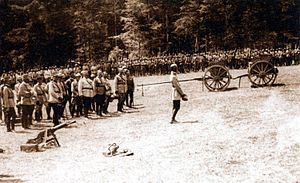Battle of Mărășești
The Battle of Mărășești (August 6, 1917 – September 8, 1917) was the last major battle between the German Empire and the Kingdom of Romania on the Romanian front during World War I. Romania was mostly occupied by the Central Powers, but the Battle of Mărășești kept the northeastern region of the country free from occupation.
Contents
1 Background
2 German counter-attack
3 Aftermath
4 Gallery
5 See also
6 References
7 External links
Background
On July 22, 1917, the Romanians launched a joint offensive with Russia against the Austro-Hungarian 1st Army, around Mărăști and the lower part of the Siret river, which resulted in the Battle of Mărăști. Although there was some initial success, a counter-offensive by the Central Powers in Galicia stopped the Romanian-Russian offensive.
German counter-attack
The offensive of the German Ninth Army, from the Army Group Mackensen, started on August 6, 1917, when the units of the Russian Fourth Army on the Siret River were expected to leave their positions to reinforce the front in the north of Moldavia and be replaced by the divisions of the Romanian First Army (commanded by General Constantin Cristescu until August 12, then by General Eremia Grigorescu).
For 29 days, until September 3, this sector was the scene of the most important battle delivered by the Romanian army during the 1917 campaign. The Battle of Mărășești had three distinct stages. During the first stage (August 6–12), successively committed to battle, the troops of the Romanian First Army, together with Russian forces, managed to arrest the enemy advance and forced the Germans, through their resistance, to gradually change the direction of their attack north-westward. In the second stage (August 13–19), the Romanian Command completely took over the command of the battle from the Russians and the confrontation reached its climax on August 19, ending in a complete thwarting of the enemy's attempts to advance. The third stage (August 20 – September 3) saw the last German attempt at least to improve their positions in view of a new offensive, this one too baffled by the Romanian response.
Starting with August 8, 1917, the fighting on the Mărășești front combined with an Austro-Hungarian-German offensive at Oituz. Holding out against superior enemy forces, by August 30 the Romanian troops stemmed the advance of the Gerok Group, successively reinforced with numerous forces and means, which only managed to achieve 2–6 km-deep and 18–20 km-wide breakthrough in the defensive disposition of the Romanian Second Army. The definitive discontinuing of the Central Powers' general offensive on the Romanian front on September 3, 1917 therefore marked their strategic defeat and a considerable weakening of their forces on the South-Eastern front.
Romania lost over 27,000 men, including 610 officers, while Germany and Austria-Hungary lost over 47,000. The Romanian heroine Ecaterina Teodoroiu was killed by machine gun fire on September 3.[2] Five days later, Karl von Wenninger, a Major General in the German Army, was killed by artillery fire near the village of Muncelu.
Aftermath
In March 1918, Russia signed the Treaty of Brest-Litovsk, and Austrian-German forces advanced in Ukraine that May. This left Romania surrounded by the Central Powers, forcing them to sign the Treaty of Bucharest.
Gallery

Battlefield monument

Mausoleum of Mărășești
German cemetery
See also
- Battle of Mărăști
- Kázím Abdulakim
- Mausoleum of Mărășești
- Romania during World War I
References
^ abc Bătălia de la Mărăşeşti, pe unde nu se trece (in Romanian)
^ "Legenda Ecaterinei Teodoroiu: Ce spun Arhivele Militare" (in Romanian). Historia.ro. Retrieved 2015-12-08..mw-parser-output cite.citation{font-style:inherit}.mw-parser-output .citation q{quotes:"""""""'""'"}.mw-parser-output .citation .cs1-lock-free a{background:url("//upload.wikimedia.org/wikipedia/commons/thumb/6/65/Lock-green.svg/9px-Lock-green.svg.png")no-repeat;background-position:right .1em center}.mw-parser-output .citation .cs1-lock-limited a,.mw-parser-output .citation .cs1-lock-registration a{background:url("//upload.wikimedia.org/wikipedia/commons/thumb/d/d6/Lock-gray-alt-2.svg/9px-Lock-gray-alt-2.svg.png")no-repeat;background-position:right .1em center}.mw-parser-output .citation .cs1-lock-subscription a{background:url("//upload.wikimedia.org/wikipedia/commons/thumb/a/aa/Lock-red-alt-2.svg/9px-Lock-red-alt-2.svg.png")no-repeat;background-position:right .1em center}.mw-parser-output .cs1-subscription,.mw-parser-output .cs1-registration{color:#555}.mw-parser-output .cs1-subscription span,.mw-parser-output .cs1-registration span{border-bottom:1px dotted;cursor:help}.mw-parser-output .cs1-ws-icon a{background:url("//upload.wikimedia.org/wikipedia/commons/thumb/4/4c/Wikisource-logo.svg/12px-Wikisource-logo.svg.png")no-repeat;background-position:right .1em center}.mw-parser-output code.cs1-code{color:inherit;background:inherit;border:inherit;padding:inherit}.mw-parser-output .cs1-hidden-error{display:none;font-size:100%}.mw-parser-output .cs1-visible-error{font-size:100%}.mw-parser-output .cs1-maint{display:none;color:#33aa33;margin-left:0.3em}.mw-parser-output .cs1-subscription,.mw-parser-output .cs1-registration,.mw-parser-output .cs1-format{font-size:95%}.mw-parser-output .cs1-kern-left,.mw-parser-output .cs1-kern-wl-left{padding-left:0.2em}.mw-parser-output .cs1-kern-right,.mw-parser-output .cs1-kern-wl-right{padding-right:0.2em}
External links
- Nițu, Victor. website: Worldwar2.ro: The battle of Mărășești
Coordinates: 45°52′48″N 27°08′05″E / 45.8800°N 27.1348°E / 45.8800; 27.1348



